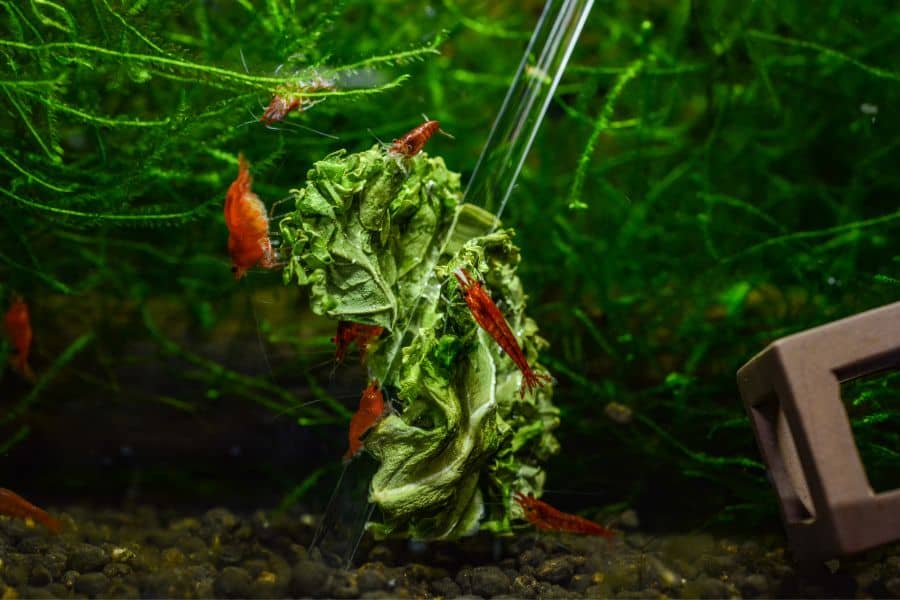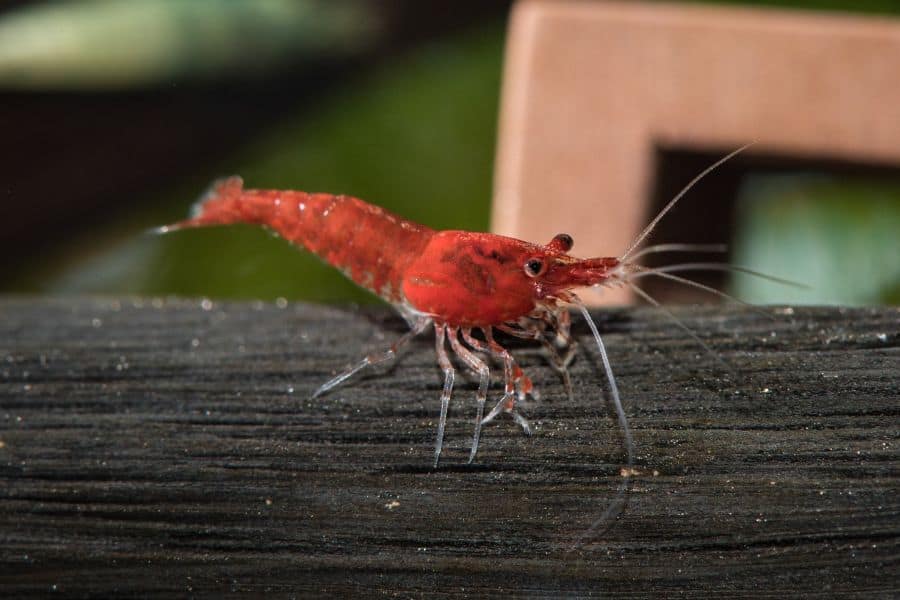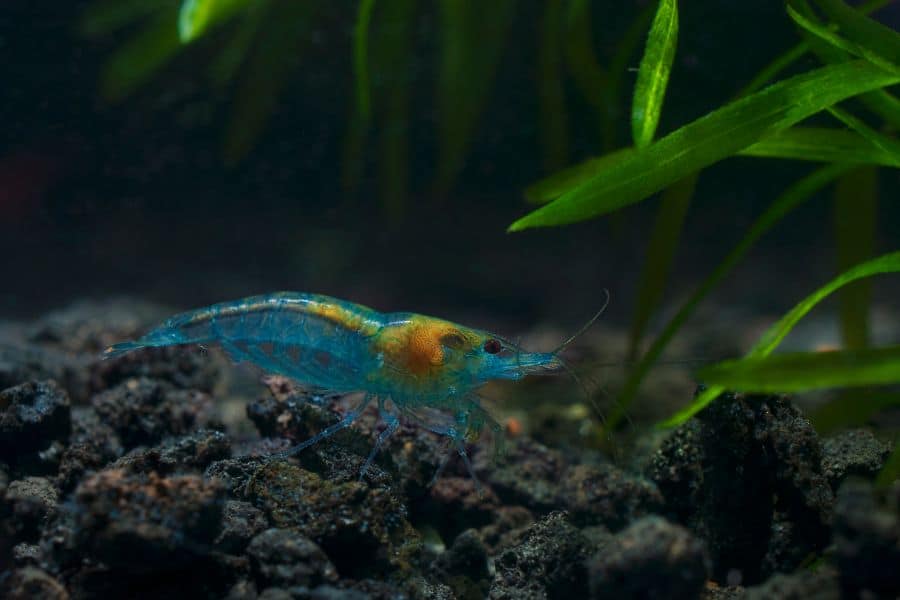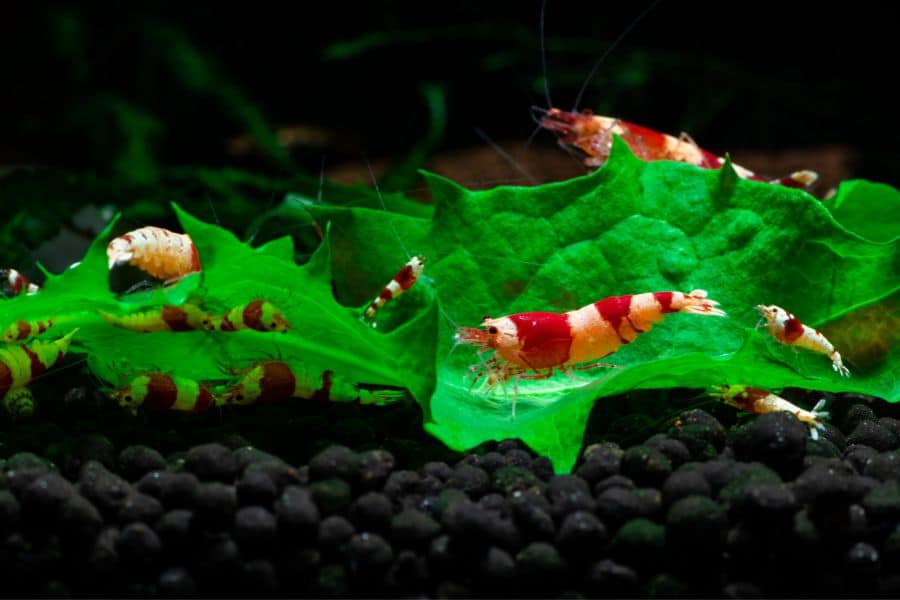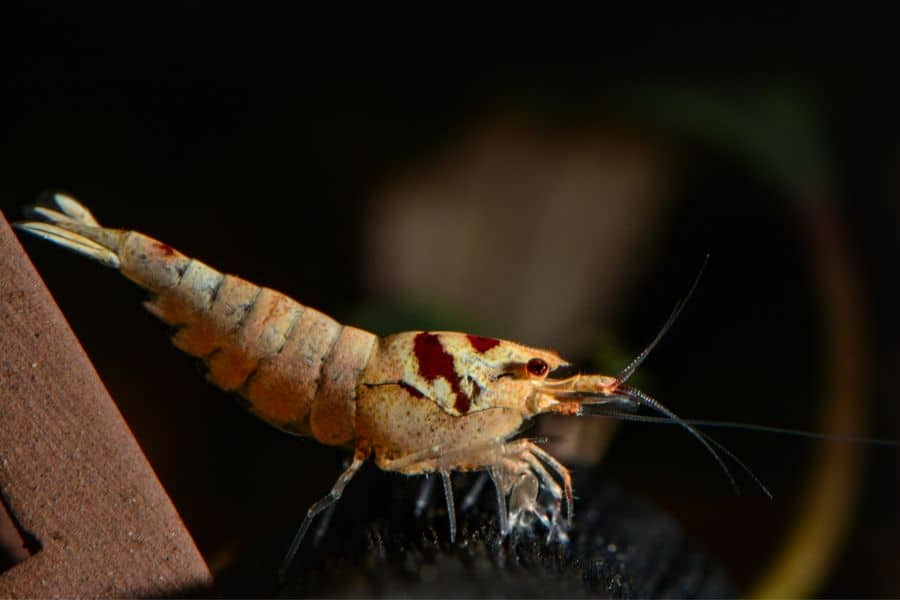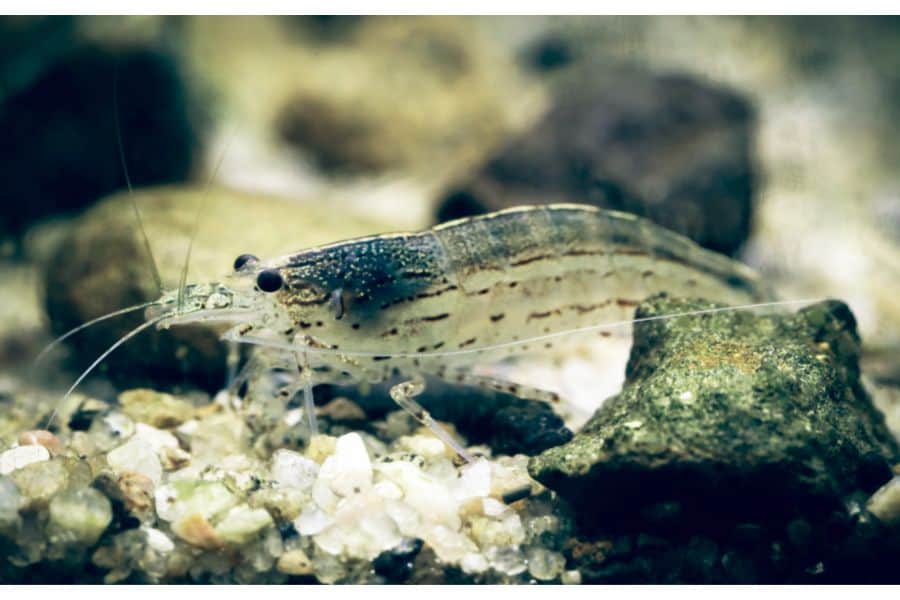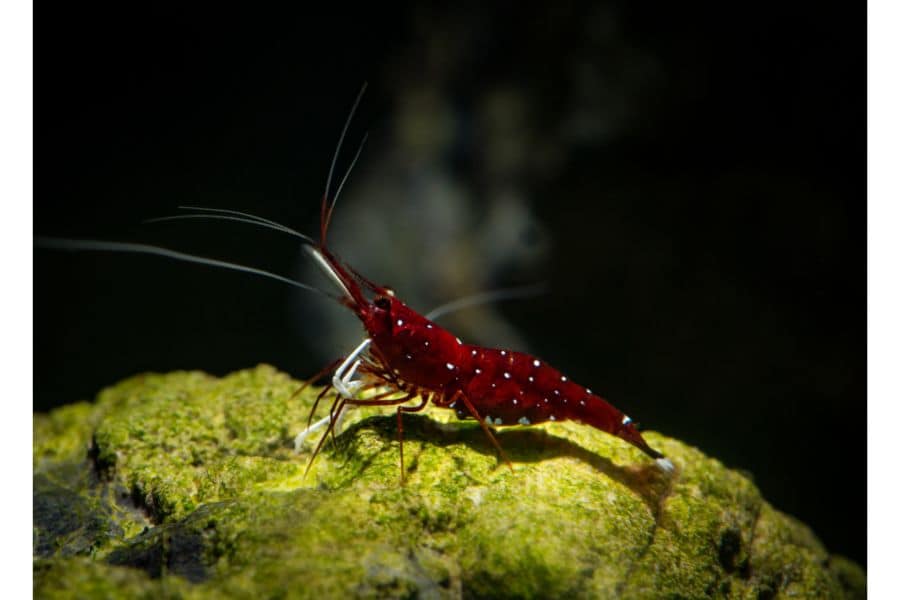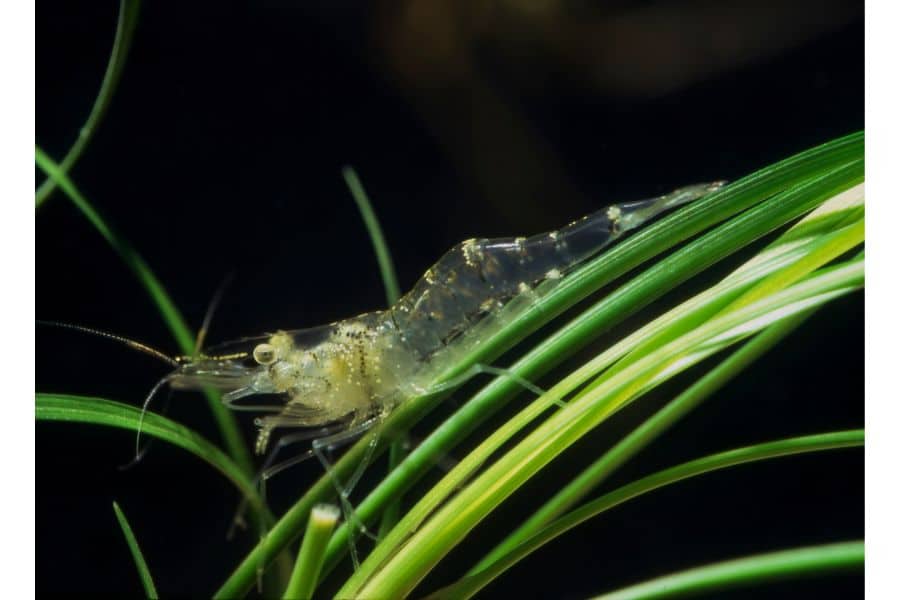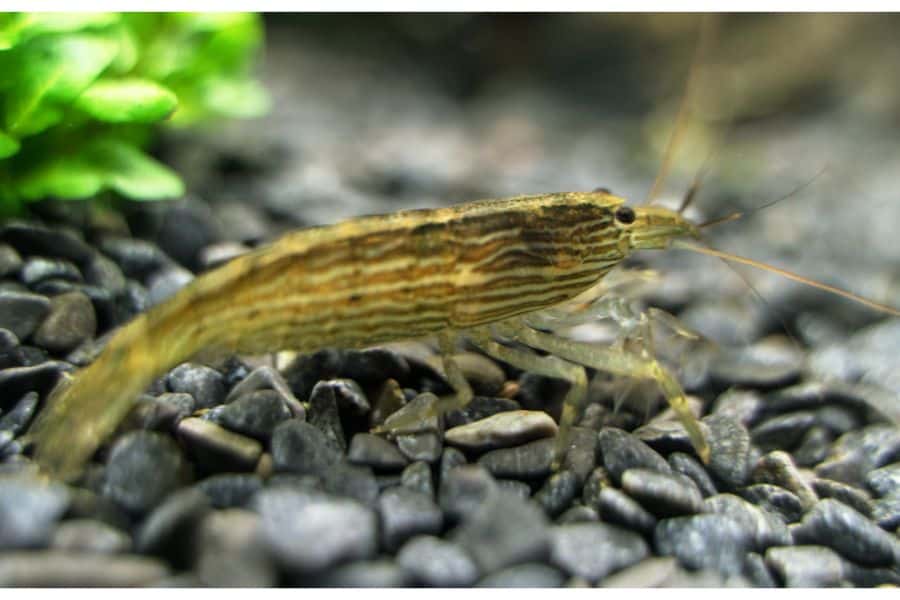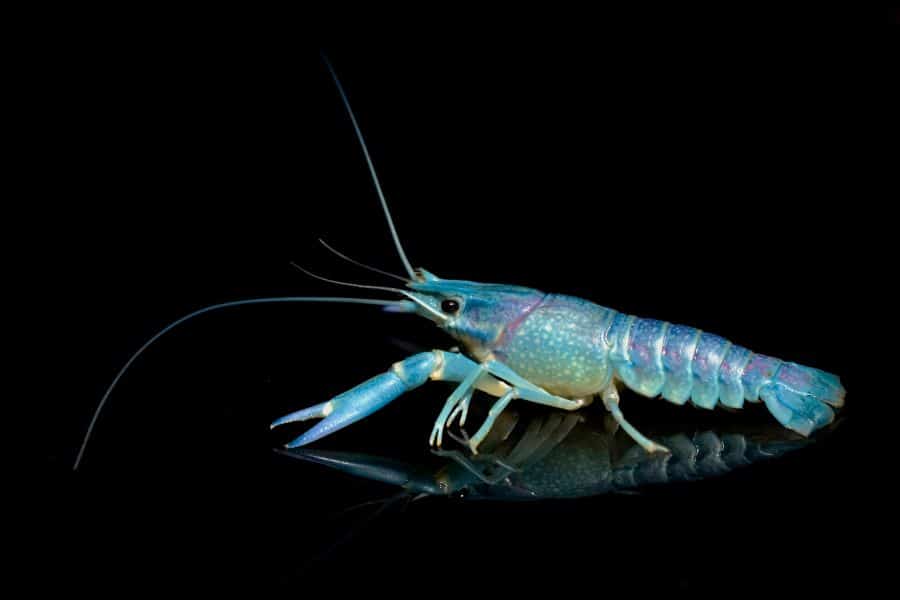Aquarium shrimp have been exploding in popularity of late, and there is an ever-increasing number of species on the market to choose from.
However, if you want them to thrive, you’ll need to know what to feed them – so to help you understand their dietary requirements, in this post, we answer the question, what do aquarium shrimp eat?
Which Species of Shrimp Can Be Kept in Aquaria?
Keeping shrimp in aquaria is a hobby that’s been booming in recent years, driven especially by attractive and colorful species of dwarf shrimp such as Neocaridina davidi and Caridina cantonensis.
However, many other shrimp species – especially freshwater shrimp – are suitable for being kept by hobbyists, with varying levels of difficulty.
The most common species found in aquaria belong to either Caridina or Neocaridina genus, and many of these species have broadly similar dietary requirements.
However, other, sometimes larger, shrimp species can also be kept, and these other species of shrimp may have quite different needs.
In any case, whichever shrimp you decide to keep in your tank, you need to find out exactly which species you have since this will allow you to provide them with the most suitable diet to enable them to thrive.
Later in this post, we’ll discuss the specific dietary requirements for some of the species of shrimp that are most commonly found in hobbyists’ aquaria – but before that, we need to say a quick word about the difference between species and morphs.
Species vs Morphs
One of the biggest problems with keeping shrimp can be working out exactly which species you’re dealing with.
Although in practice, only a relatively limited number of species are commonly kept, in theory, many species of shrimp are suitable for aquaria, and sometimes the seller might not even be sure of the precise species they’re selling to you.
This is further complicated by the fact that shrimp of different colors but belonging to the same species (known as different “morphs”) are often given creative and colorful names.
For some of the most common morphs such as the red cherry shrimp, the morph is well-established and clearly defined, so everyone knows which species it belongs to (in this case, Neocaridina davidi).
However, other names may simply be invented by an individual seller to make the shrimp seem more attractive or exotic.
For this reason, in this post, we’ve stuck to using the scientific names – because, for example, two morphs of Neocaridina davidi will have exactly the same dietary requirements, regardless of their color or what the seller calls them.
This also means when you buy shrimp for your aquarium, you should find out which species they belong to since this is what will help you decide what you need to feed them.
The Most Popular Aquarium Shrimp and What They Eat
Now let’s look at some of the most common shrimp found in aquaria and what you should feed them.
Neocaridina
Neocaridina is a genus that contains a couple of shrimp species that hobbyists can keep in aquaria, with Neocaridina davidi being the most popular.
They are easy to keep since they are unfussy when it comes to both food and water parameters, making them a good choice for beginners.
Neocaridina Davidi
- Other names: red cherry shrimp, cherry shrimp
- Common morphs: Blue dream, red rili, Sunkist orange, chocolate, yellow goldenback, green jade, yellow, blue, green, violet, black, white, transparent
- Type of diet: Omnivorous
- Difficulty level: Easy
Among the easiest and most attractive shrimp species, Neocaridina davidi is one of the most popular of all shrimp species to be kept by aquarium enthusiasts.
Although the most famous type is the so-called red cherry shrimp, they are notable for existing in a wide range of striking colors.
They are an omnivorous species, and the bulk of their diet is made up of biofilm, which they can obtain in an aquarium from the leaves of planted vegetation such as java moss and java fern. They will also eat any algae, a type of biofilm, that forms anywhere else in the tank.
A good way to ensure enough biofilm is present in your aquarium is to include pieces of submerged wood for the biofilm to grow on.
You should supplement this diet with high-quality shrimp flakes or pellets along with occasional blanched vegetables and live food.
Related: How Many Cherry Shrimp Per Gallon?
Neocaridina zhangjiajiensis
- Other names: Blue pearl, Snowball Shrimp
- Common morphs: Blue (blue pearl), white (snowball)
- Type of diet: Omnivorous
- Difficulty level: Easy
Neocaridina zhangjiajiensis is another species of shrimp belonging to the Neocaridina genus and very similar in almost all respects to Neocaridina davidi – and this includes their food, meaning you can feed them the same diet as their davidi cousins.
Caridina
Caridina is a genus of shrimp that is closely related to Neocaridina, and it contains several species that are popular among aquarists.
In general, they are a little more challenging than Neocaridina, so they are more suitable for more experienced aquarists.
Since the different species of this genus come from different regions and eat different things, you need to know the specific dietary requirements of the species you are keeping if you want them to live and thrive.
That said, most live on a mix of biofilm, vegetation and live food, so if you are keeping a less common species – or you aren’t sure exactly which species you have – you can provide them with a diet based on these elements.
Caridina cantonensis
- Common names: Bee shrimp, Crystal bee shrimp
- Common morphs: Crystal red, blue bolt, pinto, black King Kong, extreme wine red, princess bee, tangerine tiger, shadow panda
- Type of diet: Omnivorous
- Difficulty level: Moderate
Along with Neocaridina davidi, Caridina cantonensis, better known as the bee shrimp, is one of the most popular species among aquarists, mainly due to the striking colors of the various morphs.
In the wild in their native Taiwan, they are scavengers and will eat anything they can find, including biofilm, decayed vegetation and detritus.
In captivity, like with Neocaridina shrimp, you should ensure enough biofilm is growing in your aquarium for them to graze on. You should then supplement this diet with high-quality shrimp flakes or pellets along with occasional blanched vegetables and live food.
Caridina multidentate
- Common names: Amano shrimp
- Type of diet: Omnivorous
- Difficulty level: Easy
Although less attractive than either Neocaridina davidi or Caridina cantonensis, the Amano shrimp is a popular aquarium species due to its low maintenance requirements and ease of care – as well as an insatiable appetite for algae, which makes them a great cleaner species.
Indeed, the bulk of their food intake will come from algae, but algae alone won’t be enough to keep them healthy.
This means you’ll need to supplement their diet with algae wafers or spirulina flakes as well as some animal-based protein in the form of pellets or flakes. You can also feed them live or frozen daphnia or mysis.
Caridina dennerli
- Common name: Cardinal shrimp
- Type of diet: Omnivorous
- Difficulty level: Medium-advanced
A particularly handsome member of this genus is Caridina dennerli, a shrimp that originates in Lake Matano in South Sulawesi, Indonesia. This species is easily identified by its dark red body with white spots.
In its original habitat, it is considered critically endangered – or perhaps even extinct – but it is bred in captivity and becoming increasingly popular among aquarium enthusiasts due to its pleasing appearance.
To keep them, you should ensure that plenty of biofilm is growing in your tank, and you should supplement this with high-quality shrimp flakes or pellets and suitable live food such as daphnia.
Note that these shrimp are among the hardest to keep due to their demanding nature in terms of water parameters, and they should not be kept with other species.
Palaemonetes
Palaemonetes is a genus containing several species of shrimp that are often sold as food for other aquarium animals – but they can also be kept as pets.
In the US, the species you are probably most likely to come across is Palaemonetes paludosus, the American ghost shrimp. Another you may see is Palaemonetes kadiakensis, commonly called the Mississippi grass shrimp.
As common names like ghost or glass shrimp suggest, these animals are transparent so don’t have the visual appeal of some of the more interesting species, but they can still make a fun addition to your aquarium and are incredibly easy to look after.
Palaemonetes paludosus
- Common names: American ghost shrimp, ghost shrimp, glass shrimp
- Type of diet: Omnivorous
- Difficulty level: Easy
Ghost shrimp are not fussy eaters and will consume anything they find. They will happily graze on biofilm, but you should supplement their diet with high-quality flakes or pellets, occasional blanched vegetables and some live food.
Other Palaemonetes should be fed a similar diet.
Related: Can Peaceful Ghost Shrimp Live With Bettas?
Atyopsis
Atyopsis is a genus containing two species of shrimp commonly known as bamboo shrimp. They are suitable for keeping in an aquarium.
Atyopsis moluccensis
- Common names: Bamboo shrimp
- Type of diet: Omnivorous, filter feeder
- Difficulty level: Medium
Bamboo shrimp are filter feeders that catch food as it passes in the current.
As long as the water in your tank isn’t too clean, they will be happy filtering out any detritus from the water as it flows by. You just need to ensure that there is a certain amount of current in your tank.
To help them feed, you should stir up the substrate from time to time – it will make the water cloudy for a while, but it will give your shrimp something to eat.
You can also supplement their diet by adding powdered baby shrimp food, crushed fish flakes, spirulina powder or similar items to the tank from time to time.
Atyopsis moluccensis grow up to three inches in length. Atyopsis spinipes, the dwarf bamboo shrimp is smaller and can be fed the same diet.
Atya
Atya gabonensis
- Common names: Vampire shrimp
- Type of diet: Omnivorous filter feeder
The dramatically named vampire shrimp is a large filter feeder that can grow up to six inches in length.
They feed in a similar way to bamboo shrimp, and their diets can also be supplemented by finely ground fish food, spirulina powder, crushed fish flakes and so on.
Note that if you see these shrimp foraging in the substrate, it can be an indication that they aren’t getting enough food from the water, so you should increase the amount of supplemental food you give them.
Also Read:
- What Do Crabs Eat?
- What Do Crayfish Eat?
- Can Shrimp Live with Betta?
- Dwarf Freshwater Shrimp: Popular Types & Care
- What Do Axolotls Eat?
FAQs
How Often Should You Feed Your Shrimp?
Although it can vary from species to species, most aquarists feed their shrimp every other day. This way, no food is left over to go bad and create ammonia in the water.
If you find that all the food you give your shrimp is being eaten quickly, you might prefer to increase feeding to once a day – but you should monitor the food to make sure none remains after they feed.
What Should You Feed Your Shrimp if You Don’t Know Which Species They Are?
While you should make every effort to find out the precise species of shrimp you are buying, if you don’t know, you should at least try to find out which genera they belong to.
To do this, compare them to some of the better-known species and try to make an educated guess.
This way, you will be able to feed them a diet that is suitable for other members of the same genera.
In practice, it should be quite obvious if you have shrimp that belong to the Neocaridina or Caridina genera, in which case the shrimp will feed themselves on biofilm, and you can supplement their diet with flakes, pellets, blanched vegetables and live food.
If you think the shrimp belongs to another genus, you should try to feed it a diet that most closely matches the most popular species of that genus.
If you really don’t know what to feed your shrimp, you should give them the same diet as you would for Neocaridina or Caridina species – but this should be a last resort since it’s not advisable to keep shrimp if you don’t even know which genus they belong to!
What Are the Most Popular Aquarium Shrimp Species?
Probably the most popular types of shrimp kept in aquaria are Neocaridina davidi (red cherry shrimp) and Palaemonetes paludosus(ghost shrimp).
Which Are the Easiest to Keep?
The easiest shrimp to keep – both in terms of food and water conditions – are Neocaridina davidi and shrimp belonging to the genus Palaemonetes.
Can You Keep Different Types of Shrimp Together?
Some of the species of shrimp we’ve mentioned in our list can be kept together.
If the shrimp are non-aggressive, eat a similar diet and can tolerate similar water conditions, they should be able to co-exist harmoniously.
However, if you keep certain larger species of shrimp in the same aquarium as smaller ones, you might find the big ones start eating the small ones.
Find out Which Species You Have and Feed Them a Suitable Diet
One of the keys to keeping healthy shrimp in an aquarium is to feed them the right food. Make sure you know which species of shrimp you are feeding and find out the types of food they like to eat – and then make sure you give them a healthy, balanced diet to feed on.
